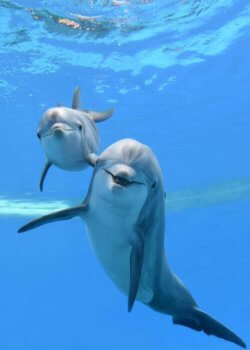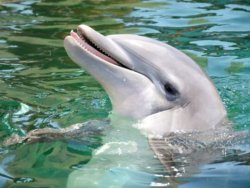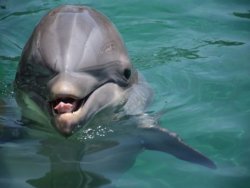Earlier this month, on June 2nd, at Chicago’s Brookfield Zoo, Maxine, a bottlenose dolphin, died of what the zoo has called an acute bacterial infection that “quickly caused organ failure.”

Maxine with her mother, Allie, at the Brookfield Zoo
Maxine was three years old.
“Maxine’s death has been devastating to all of the Chicago Zoological Society family and she will be greatly missed,” said Bill Zeigler, senior vice president of animal programs.
But however “devastating” the loss of Maxine may have been to her zoo “family,” it is likely nothing compared to the grief being experienced by her mother, 32-year-old Allie. Whales and dolphins, like elephants, are known for their behavior in response to the loss of one of their own. Only last week, a new paper was published that explores the evidence for grief and “postmortem attentive behavior” among various species of cetaceans.
For her zoo “family,” meanwhile, Maxine’s death must also have been something of an embarrassment since this was just the latest in a string of young dolphin deaths at the zoo. In 2014, two dolphin calves died at the zoo, and three years earlier a four-year-old died after apparently colliding with another dolphin in their concrete tank and suffering a fractured skull.

Alia at Dolphinaris
Maxine’s death also comes hard on the heels of the demise of Alia, a 10-year-old bottlenose dolphin who passed away on May 22nd at Dolphinaris Arizona. Dolphinaris, a Mexican-owned swim-with-the-dolphins facility outside of Scottsdale, Arizona, has yet to report whether they have done a necropsy and what it may have told them.
Alia spent her short life being shipped around the country. Born at SeaWorld Orlando in 2007, she was transferred to Discovery Cove in Orlando, then across the country to Six Flags Discovery Kingdom in California, and finally to Dolphinaris Arizona when it opened in 2016.

Bodie at Dolphinaris
She is the second dolphin to lose her life at Dolphinaris in less than two years. In September 2017, Dolphinaris lost Bodie from what the company called a rare muscle disorder. Animal protection groups, however, suspect that the true cause of death was valley fever, a fungal disease that can lead to deadly respiratory infections. Dolphins are highly susceptible to respiratory ailments and their immune systems are weakened by the stress associated with captivity. Before Dolphinaris was ever built, the Animal Defense League of Arizona (ADLA) and other organizations were issuing warnings that housing dolphins in a dusty desert environment could be fatal.
Following Alia’s death, the ADLA wrote: “Bodie’s death was tragic and preventable, and it’s likely that Alia also died from respiratory disease.”
There’s growing public sentiment that whales and dolphins don’t belong in zoos and marine entertainment centers, whether in big cities in the Midwest, in the desert Southwest, or at any vacation resort. Two weeks ago, Rolling Stone published an article about the pop star Pink after she had sent an email to SeaWorld asking the company to retire its orcas and other marine mammals to seaside sanctuaries. In her email, Pink made this powerful statement:
Singer Pink in 2013 – by Wikimedia Commons
“As a mother, I would never take my kids anywhere that keeps intelligent, sensitive beings in intensive confinement. Children are impressionable, and the last thing I would want to teach my kids is that “might makes right” or that it’s OK to bully and exploit someone just because they look different from us.
But that’s exactly what SeaWorld does by locking up animals who, in their ocean homes, would swim up to 140 miles a day, dive to great depths, cooperate with their pods to find food, communicate in their own dialects, and transmit their own culture from generation to generation. At SeaWorld, all these animals are able to do is swim in endless circles. Some are so frustrated that they break their teeth by gnawing on the concrete corners and metal bars of their tiny tanks.
“But you have a chance to change all that – and do right by orcas and other animals – by sending them to sanctuaries, where they can live a more natural life and receive care for as long as they need it, as well as by making future locations, including your planned park in Hainan Island, China, virtual reality centers without any live animals. People could then feel good about taking their families to your parks. So, my question is this:
“When will SeaWorld transfer its orcas and other marine mammals to seaside sanctuaries to save them – and itself?”
Public opinion has already driven circuses to begin retiring elephants and other land-based animals to sanctuaries. Now it’s time for the marine theme parks to do the same by giving these animals a new life in an environment that’s as close as possible to their natural habitat.

2 Comments
We need more like this, no matter how many petitions are signed nothing seems to change–if more famous names could make a stand like Pink has done they can reach so many younger generations and make a hugh difference by making fans realise how desparatly important this issue is–famous names can do so much with the power they have over public opinion it would be a shame not to use that voice.
Whales and dolphins don’t belong in zoos and marine entertainment centers!